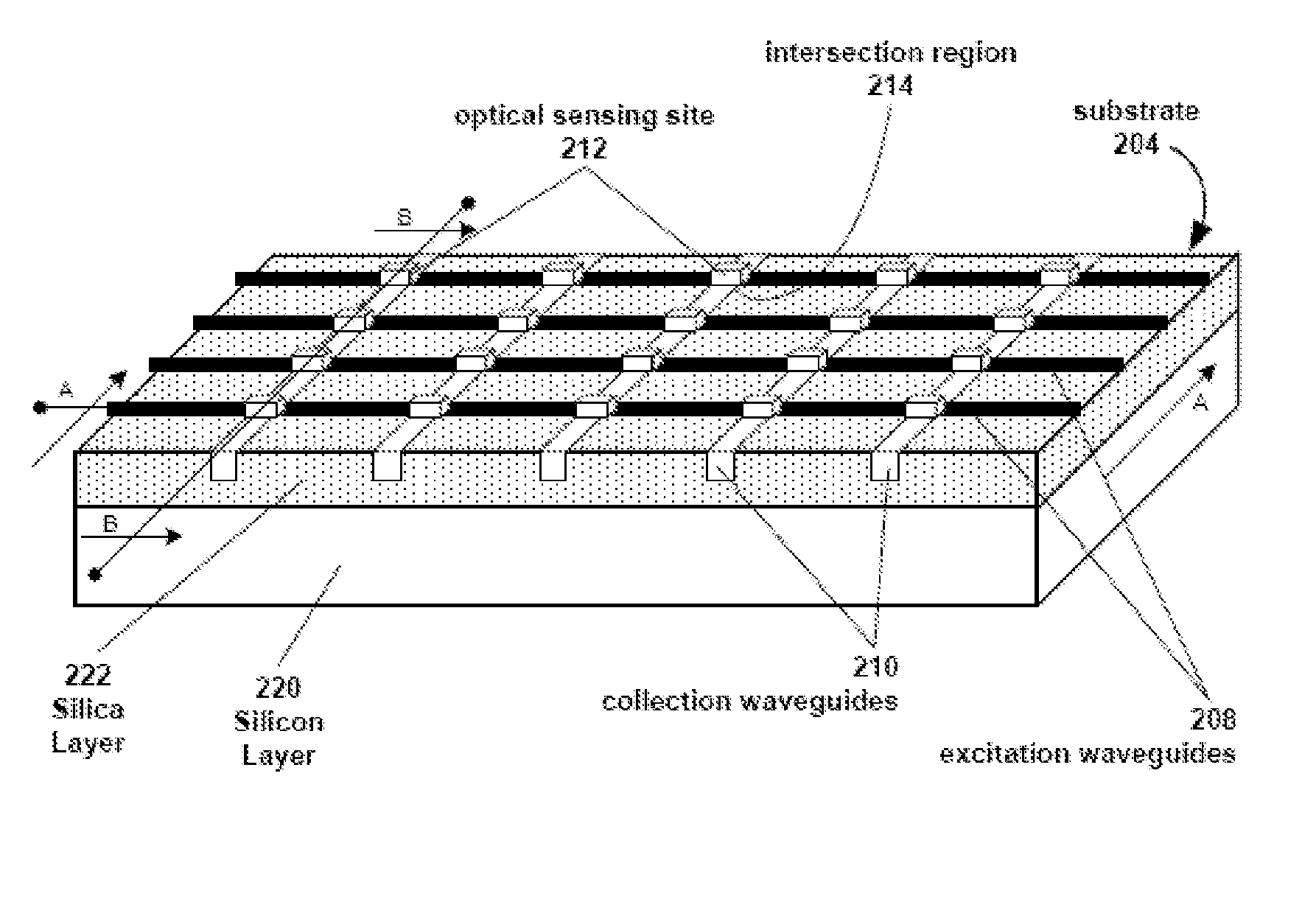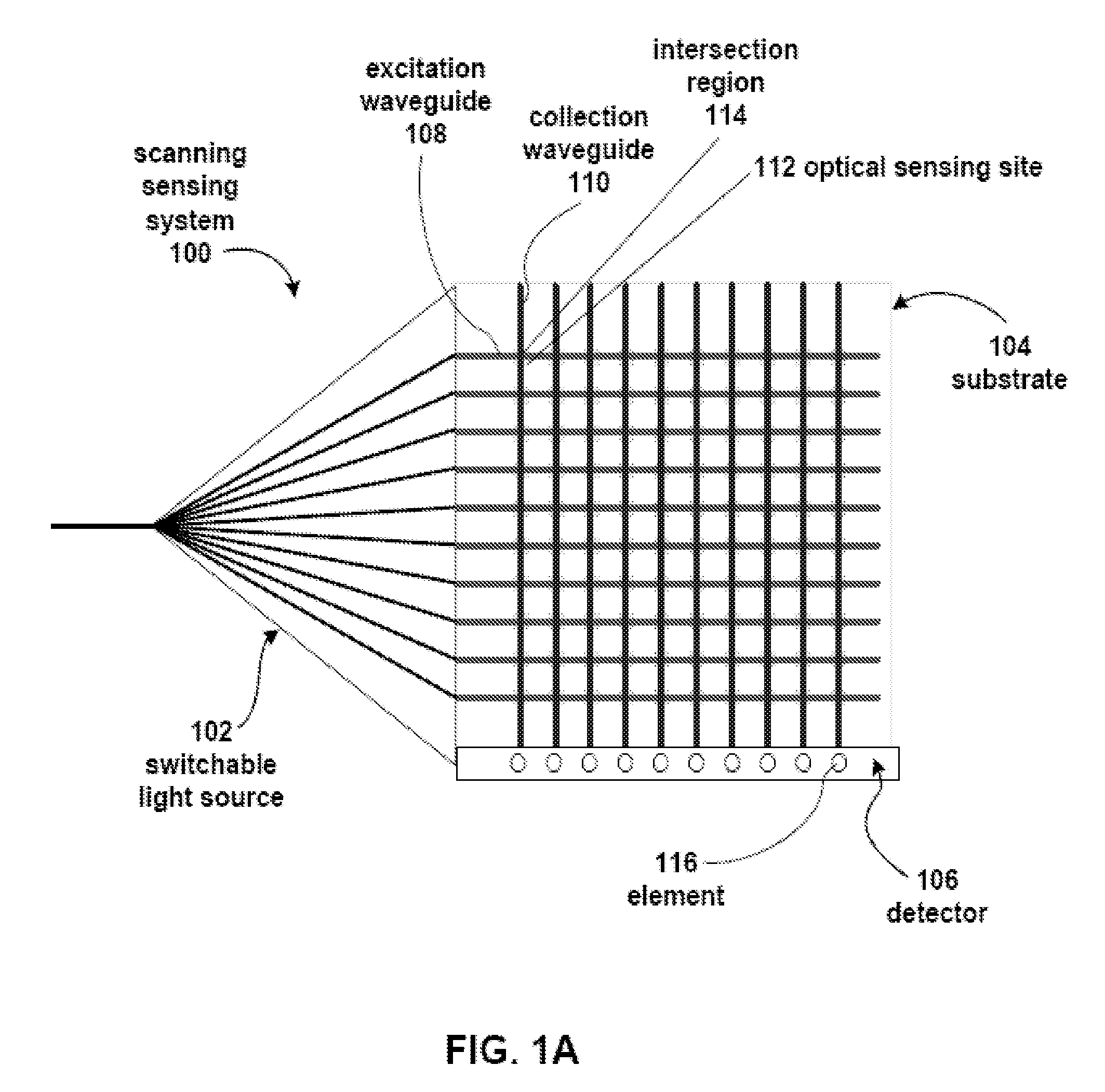Optical Scanning System
a scanning system and optical technology, applied in the field of optical scanning system, can solve the problems of limited signal strength, short interaction length between bio-samples, and high background or nois
- Summary
- Abstract
- Description
- Claims
- Application Information
AI Technical Summary
Benefits of technology
Problems solved by technology
Method used
Image
Examples
##ic example 1
Prophetic Example 1
[0241]Quantitative real-time PCR detection of transcripts, for example, bcr / abl fusion transcripts, can be achieved using a scanning sensing system such as the example illustrated in FIG. 1A using a PCR assay protocol modified from that described by Kreuzer et al. (supra). The system includes a substrate chip with excitation waveguides, collection waveguides and intersection regions. The intersection regions where the excitation waveguides and collection waveguides cross include optical sensing sites with sensing wells for conducting quantitative real-time PCR. The scanning sensing system further includes a dynamic switchable light source coupled to the substrate and the excitation waveguides. The system further includes an optical detector.
[0242]Samples suspected of containing RNA transcripts of interest (e.g., blood from a subject) are treated to obtain a source of total RNA which is subsequently reverse transcribed using reverse transcriptase into cDNA using te...
##ic example 2
Prophetic Example 2
[0246]Fluorescent immunoassay-based detection of HIV+ status of multiple subjects can be achieved using a scanning sensing system such as the example illustrated in FIG. 1A. The system includes a substrate chip with excitation waveguides, collection waveguides and intersection regions. The intersection regions where the excitation waveguides and collection waveguides cross include optical sensing sites with sensing wells for conducting fluorescent immunoassays. The scanning sensing system further includes a dynamic switchable light source coupled to the substrate and the excitation waveguides. The system further includes an optical detector.
[0247]A partially purified antigen, for example, inactivated HIV protein p29 antigen, is pre-coated onto the sensing wells of the optical sensing sites. Next, a number subject serums which may contain antibodies to HIV p29 are delivered to separate sensing sites. If a subject is HIV+, then their serum may contain antibodies to ...
##ic example 3
Prophetic Example 3
[0249]A two-site sandwich immunoassay can be employed in assays using the scanning sensing system of the invention (e.g., the system as illustrated in FIG. 1A). Antibodies fulfill two different roles in such assays; an immobilized antibody captures the analyte, while a soluble, fluorescently labeled antibody detects or “traces” analyte binding. To prevent competitive binding, capture and tracer antibodies must bind to different sites on the analyte molecule. For large analytes with repetitive epitopes (e.g., viruses and bacteria), a single antibody (specific for the repetitive epitope) can usually be employed in both capture and tracer roles. Smaller analytes (e.g. proteins and polysaccharides) expressing multiple, unique epitopes require two different antibodies, each specific for a unique epitope.
[0250]Three two-site sandwich immunoassay tests are envisioned: 1) serial testing of optical sensing sites; 2) low complexity parallel testing of optical sensing sites;...
PUM
 Login to View More
Login to View More Abstract
Description
Claims
Application Information
 Login to View More
Login to View More - R&D
- Intellectual Property
- Life Sciences
- Materials
- Tech Scout
- Unparalleled Data Quality
- Higher Quality Content
- 60% Fewer Hallucinations
Browse by: Latest US Patents, China's latest patents, Technical Efficacy Thesaurus, Application Domain, Technology Topic, Popular Technical Reports.
© 2025 PatSnap. All rights reserved.Legal|Privacy policy|Modern Slavery Act Transparency Statement|Sitemap|About US| Contact US: help@patsnap.com



